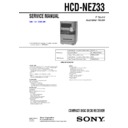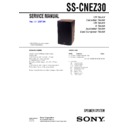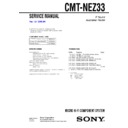Read Sony CMT-NEZ33 / HCD-NEZ33 Service Manual online
SERVICE MANUAL
COMPACT DISC DECK RECEIVER
HCD-NEZ33
Ver. 1.0 2006.04
SPECIFICATIONS
9-887-201-01
2006D05-1
© 2006.04
© 2006.04
Sony Corporation
Personal Audio Division
Published by Sony Techno Create Corporation
Published by Sony Techno Create Corporation
E Model
Australian Model
•
HCD-NEZ33 is the amplifier, CD player, tape deck
and tuner section in CMT-NEZ33.
and tuner section in CMT-NEZ33.
Model Name Using Similar Mechanism
HCD-EH10
CD Section
Base Unit Name
BU-K8BD83S-WOD
Optical Pick-up block Name
KSM-213CDP
TAPE Section
Model Name Using Similar Mechanism
NEW
Tape Transport Mechanism Type
CMAL5Z235A
Amplifier section
The following are measured at AC 230 – 240 V, 50/60 Hz (Australian model),
AC 220 V, 60 Hz (Korean model), AC 120 V, 50/60 Hz (Taiwanese model),
AC 120, 220 or 230 – 240 V, 50/60 Hz (other models)
AC 220 V, 60 Hz (Korean model), AC 120 V, 50/60 Hz (Taiwanese model),
AC 120, 220 or 230 – 240 V, 50/60 Hz (other models)
DIN power output (rated): 14 + 14 W (6 ohms at 1 kHz, DIN)
Continuous RMS power output (reference): 20 + 20 W (6 ohms at 1 kHz,
10% THD)
Continuous RMS power output (reference): 20 + 20 W (6 ohms at 1 kHz,
10% THD)
Inputs
AUDIO IN: Sensitivity 250 mV, impedance 47 kilohms
Outputs
PHONES: Accepts headphones with an impedance of 8 ohms or more
SPEAKER: Accepts impedance of 6 to 16 ohms
SPEAKER: Accepts impedance of 6 to 16 ohms
CD player section
System: Compact disc and digital audio system
Laser Diode Properties
Laser Diode Properties
Emission Duration: Continuous
Laser Output*: Less than 44.6
Laser Output*: Less than 44.6
µ
W
* This output is the value measurement at a distance of 200 mm from the
objective lens surface on the Optical Pick-up Block with 7mm aperture.
Tape deck section
Recording system: 4-track 2-channel, stereo
Tuner section
FM stereo, FM/AM superheterodyne tuner
FM tuner section:
Tuning range
Antenna: FM lead antenna
Antenna terminals: 75 ohms unbalanced
Intermediate frequency: 10.7 MHz
Antenna terminals: 75 ohms unbalanced
Intermediate frequency: 10.7 MHz
AM tuner section:
Tuning range
530 – 1,710 kHz (with 10 kHz tuning interval)
87.5 – 108.0 MHz (50 kHz step)
531 – 1,602 kHz (with 9 kHz tuning interval)
Antenna: AM loop antenna, external antenna terminal
Intermediate frequency: 450 kHz
Intermediate frequency: 450 kHz
General
Power requirements
Australian model: AC 230 – 240 V, 50/60 Hz
Korean model: AC 220 V, 60 Hz
Taiwanese model: AC 120 V, 50/60 Hz
Other models: AC 120, 220 or 230 – 240 V, 50/60 Hz
Adjustable with voltage selector
Korean model: AC 220 V, 60 Hz
Taiwanese model: AC 120 V, 50/60 Hz
Other models: AC 120, 220 or 230 – 240 V, 50/60 Hz
Adjustable with voltage selector
Power consumption:
50 watts
Dimensions (w/h/d) (excl. speakers):
Mass (excl. speakers):
Approx. 3.6 kg
Approx. 164
×
235
×
265 mm
Design and specifications are subject to change without notice.
2
HCD-NEZ33
Notes on chip component replacement
•
Never reuse a disconnected chip component.
•
Notice that the minus side of a tantalum capacitor may be
damaged by heat.
Flexible Circuit Board Repairing
•
Keep the temperature of the soldering iron around 270 ˚C
during repairing.
•
Do not touch the soldering iron on the same conductor of the
circuit board (within 3 times).
•
Be careful not to apply force on the conductor when soldering
or unsoldering.
CAUTION
Use of controls or adjustments or performance of procedures
other than those specified herein may result in hazardous radiation
exposure.
other than those specified herein may result in hazardous radiation
exposure.
SAFETY-RELATED COMPONENT WARNING!!
COMPONENTS IDENTIFIED BY MARK
0
OR DOTTED LINE
WITH MARK
0
ON THE SCHEMATIC DIAGRAMS AND IN
THE PARTS LIST ARE CRITICAL TO SAFE OPERATION.
REPLACE THESE COMPONENTS WITH SONY PARTS WHOSE
PART NUMBERS APPEAR AS SHOWN IN THIS MANUAL OR
IN SUPPLEMENTS PUBLISHED BY SONY.
REPLACE THESE COMPONENTS WITH SONY PARTS WHOSE
PART NUMBERS APPEAR AS SHOWN IN THIS MANUAL OR
IN SUPPLEMENTS PUBLISHED BY SONY.
This appliance is
classified as a CLASS
1 LASER product. This
marking is located on the
rear exterior.
classified as a CLASS
1 LASER product. This
marking is located on the
rear exterior.
3
HCD-NEZ33
TABLE OF CONTENTS
1.
SERVICING NOTES
...............................................
3
2.
GENERAL
...................................................................
6
3.
DISASSEMBLY
3-1.
Disassembly Flow ...........................................................
8
3-2.
Cabinet .............................................................................
8
3-3.
Cabinet (Top) Section ......................................................
9
3-4.
Base Unit (BU-K8BD83S-WOD) ...................................
9
3-5.
Front Panel Section ......................................................... 10
3-6.
Tape Mechanical Deck (CMAL5Z235A) ........................ 10
3-7.
MAIN Board .................................................................... 11
3-8.
Tuner (FM/AM) ............................................................... 11
4.
TEST MODE
.............................................................. 12
5.
MECHANICAL ADJUSTMENTS
....................... 13
6.
ELECTRICAL ADJUSTMENTS
......................... 14
7.
DIAGRAMS
7-1.
Block Diagram – CD SERVO Section – ......................... 17
7-2.
Block Diagram – MAIN Section – .................................. 18
7-3.
Printed Wiring Board – CD Board – ............................... 20
7-4.
Schematic Diagram – CD Board – .................................. 21
7-5.
Printed Wiring Boards – MAIN Section – ...................... 22
7-6.
Schematic Diagram – MAIN Section (1/2) – .................. 24
7-7.
Schematic Diagram – MAIN Section (2/2) – .................. 25
7-8.
Printed Wiring Board – PANEL Board (Suffix-13) – ..... 26
7-9.
Schematic Diagram – PANEL Board (Suffix-13) – ........ 27
7-10. Printed Wiring Board – PANEL Board (Suffix-14) – ..... 28
7-11. Schematic Diagram – PANEL Board (Suffix-14) – ........ 29
7-12. Printed Wiring Boards – DC Section – ........................... 30
7-13. Printed Wiring Board – AC Board – ................................ 31
7-14. Schematic Diagram – POWER SUPPLY Section – ........ 32
7-11. Schematic Diagram – PANEL Board (Suffix-14) – ........ 29
7-12. Printed Wiring Boards – DC Section – ........................... 30
7-13. Printed Wiring Board – AC Board – ................................ 31
7-14. Schematic Diagram – POWER SUPPLY Section – ........ 32
8.
EXPLODED VIEWS
8-1.
Cabinet Section ................................................................ 38
8-2.
Mechanical Deck Section ................................................ 39
8-3.
PANEL Board Section ..................................................... 40
8-4.
Cabinet (Top) Section ...................................................... 41
8-5.
MAIN Board Section ....................................................... 42
8-6.
AC Board, DC Board Section ......................................... 43
9.
ELECTRICAL PARTS LIST
................................ 44
The laser diode in the optical pick-up block may suffer electrostatic
break-down because of the potential difference generated by the
charged electrostatic load, etc. on clothing and the human body.
During repair, pay attention to electrostatic break-down and also
use the procedure in the printed matter which is included in the
repair parts.
The flexible board is easily damaged and should be handled with
care.
break-down because of the potential difference generated by the
charged electrostatic load, etc. on clothing and the human body.
During repair, pay attention to electrostatic break-down and also
use the procedure in the printed matter which is included in the
repair parts.
The flexible board is easily damaged and should be handled with
care.
NOTES ON HANDLING THE OPTICAL PICK-UP
BLOCK OR BASE UNIT
BLOCK OR BASE UNIT
SECTION 1
SERVICING NOTES
UNLEADED SOLDER
Boards requiring use of unleaded solder are printed with the lead-
free mark (LF) indicating the solder contains no lead.
(Caution: Some printed circuit boards may not come printed with
free mark (LF) indicating the solder contains no lead.
(Caution: Some printed circuit boards may not come printed with
the lead free mark due to their particular size)
: LEAD FREE MARK
Unleaded solder has the following characteristics.
•
Unleaded solder melts at a temperature about 40 ˚C higher
than ordinary solder.
Ordinary soldering irons can be used but the iron tip has to be
applied to the solder joint for a slightly longer time.
Soldering irons using a temperature regulator should be set to
about 350 ˚C.
Caution: The printed pattern (copper foil) may peel away if
Caution: The printed pattern (copper foil) may peel away if
the heated tip is applied for too long, so be careful!
•
Strong viscosity
Unleaded solder is more viscou-s (sticky, less prone to flow)
Unleaded solder is more viscou-s (sticky, less prone to flow)
than ordinary solder so use caution not to let solder bridges
occur such as on IC pins, etc.
occur such as on IC pins, etc.
•
Usable with ordinary solder
It is best to use only unleaded solder but unleaded solder may
It is best to use only unleaded solder but unleaded solder may
also be added to ordinary solder.
NOTES ON LASER DIODE EMISSION CHECK
The laser beam on this model is concentrated so as to be focused on
the disc reflective surface by the objective lens in the optical pick-
up block. Therefore, when checking the laser diode emission,
observe from more than 30 cm away from the objective lens.
the disc reflective surface by the objective lens in the optical pick-
up block. Therefore, when checking the laser diode emission,
observe from more than 30 cm away from the objective lens.
4
HCD-NEZ33
LASER DIODE AND FOCUS SEARCH OPERATION
CHECK
CHECK
During normal operation of the equipment, emission of the laser
diode is prohibited unless the upper lid is closed while turning ON
the S820. (push switch type)
The following checking method for the laser diode is operable.
diode is prohibited unless the upper lid is closed while turning ON
the S820. (push switch type)
The following checking method for the laser diode is operable.
•
Method
Emission of the laser diode is visually checked.
Emission of the laser diode is visually checked.
1. Open the upper lid.
2. Push the S820 as shown in Fig.1.
2. Push the S820 as shown in Fig.1.
Note:
Do not push the detection lever strongly, or it may be bent or damaged.
3. Press the
u
button.
4. Check the object lens for confirming normal emission of the
laser diode. If not emitting, there is a trouble in the automatic
power control circuit or the optical pick-up.
In this operation, the object lens will move up and down 2
times along with inward motion for the focus search.
power control circuit or the optical pick-up.
In this operation, the object lens will move up and down 2
times along with inward motion for the focus search.
Fig.1 Method to push the S820
S820
MODEL IDENTIFICATION
– Rear View –
– Rear View –
Model Name
Part No.
Singapore model
2-665-903-0[]
Australian model
2-665-904-0[]
Taiwan model
2-665-905-0[]
Korean model
2-665-906-0[]
Part No.
SUFFIX-13/SUFFIX-14 OF PANEL BOARD
DESCRIPTION
DESCRIPTION
In this set, PANEL board has been changed in the midway of
production.
Distinguish which substrate it is referring to the figure below, and
to the repair suitable for of each.
production.
Distinguish which substrate it is referring to the figure below, and
to the repair suitable for of each.
– PANEL Board (Component Side) –
Suffix-13 : 1-869-181-13
Suffix-14 : 1-869-181-14
Suffix-14 : 1-869-181-14



